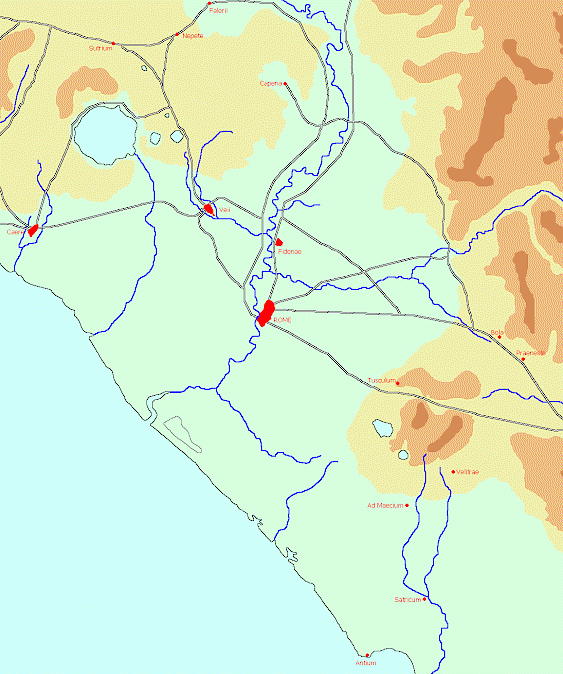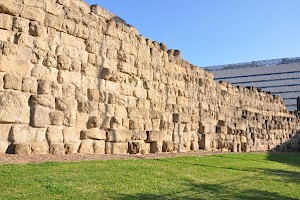Marcus Furius Camillus (4)
Marcus Furius Camillus (c.435-365 VC): Roman general and statesman, captured Veii, annexed Tusculum and put an end to the conflict of the orders. He was called the "second founder" of Rome.
Social Struggles

The years after the battle of Ad Maecium saw a renewal of the social struggles in Rome. As we have seen above, there were two problems: the patricians refused to give equal rights to the nouveaux riches, and there were many very poor people. In 385 (according to the Varronian chronology), the second group found a champion: Marcus Manlius Capitolinus, the man who had saved the Capitol in 390 V (above). Our sources often use the word 'plebeians' to indicate the forces of opposition against the rich patricians, but they do not always clearly distinguish between the two groups of plebeians, the nouveaux riches and the poor.
Livy's portrait of Capitolinus is ambiguous. The historian says that the war hero was a proud man who felt that he was very important because he had saved Rome, but felt that it was unfair that Camillus was regarded as the most important senator of his age. On the other hand, Livy admits that Capitolinus had a social heart. When he saw that a man was about to be sold as slave because he was unable to pay his debts, he paid the money and had the man released.
It is probable that the ambiguity in Livy's portrayal is a consequence of the ambiguity of his sources, which were partly written in the late second century and were influenced by the social conflicts of that age. To some second-century politicians, Capitolinus was a villain, to others, he was a real hero. Moreover, Livy gives his story extra color by turning Capitolinus into a social revolutionary like the first-century reformer Lucius Sergius Catilina.
Capitolinus sided with the impoverished plebeians and the other patricians hated him. It is possible - perhaps even likely - that at this time, there was a debt crisis: many people must have made large debts after the Gallic catastrophe. However, we cannot be completely certain about this, especially now that archaeology has shown that the catastrophe was less catastrophic than historians had expected. What is certain is that Capitolinus was becoming dangerously popular and that many people thought that he was aiming at the one forbidden office of republican Rome: he wanted to become sole ruler or king.
In the same year, the dictator Aulus Cornelius Cossus is said to have defeated the Volsci and founded a Roman colony at Satricum, the town that Camillus had conquered in the preceding year. 2,000 poor Romans could start a new life by settling there. The measure shows that the Senate understood that the root of Capitolinus' sedition was not his ambition, but poverty. However, it turned out to be an insufficient solution.
If we are to believe Livy, Rome remained unquiet in 384, when Marcus Furius Camillus was military tribune with consular powers again. Capitolinus was now arrested and accused of an attempt to become king; but when the people's assembly gathered to judge the case, the people saw the Capitol and refused to condemn him. After this, the tribunes reconvened the assembly on a place where the Capitol was invisible, and now Capitolinus was sentenced to death. He was thrown down from the Tarpeian Rock.
Livy and other sources are extremely confused, and it is impossible to find out how the story about the events in 384 came into being. However this may have happened, the story is untrue, and it is certain that at least part of it was created by someone who wanted to have the two heroes of the struggle against the Gauls were opposed. What is certain is that Capitolinus tried to subvert the constitution, was supported by poor plebeians, and met a violent death in 385 - not 384. We may assume that dictator Aulus Cornelius Cossus played a more important role than Livy suggests.
Meanwhile, the situation in the south was deteriorating. The Romans had been successful against the Volsci, and this caused discontent among the Latin allies. Rumors about their unhappiness had been ignored until now, but in 382, the Roman legions marched again to the south, against Velitrae. According to Livy, they defeated the enemy but did not want to besiege a town of the Latins, who were, after all, related to the Romans.
The truth may be that they were in fact defeated. Livy admits that the enemy army had been reinforced by soldiers from Praeneste (after Rome the most powerful city in Latium) and that this surprised the Romans; and he tells that the united army of the enemy proceeded to capture the newly founded Roman colony at Satricum. It seems that a coalition of the Volsci from southern Latium, Velitrae and Praeneste was made.
Next year, 381 V, Camillus was elected as military tribune, and his nephew Lucius Furius Medullinus (the son of Camillus' brother Spurius) was to be one of his colleagues. They had to fight a war against the coalition and marched on Satricum. According to Livy, Lucius underestimated the dangers of the battle, but his uncle prevented disaster, and the Romans were ultimately victorious. However, their success at Satricum was only partial, because the city was not taken.
When the captives were counted, Livy says, it was discovered that there were people from Tusculum among them. Camillus and his army marched to this Latin city. Without violence, the town was simply annexed: from now on, the Tusculans were Romans with full citizenship. It is possible that the two commanders of the Roman army had connections with Tusculum (above) and that this enabled the unusual, bloodless outcome of the war.
Camillus was now an old man, almost 55 years old. Two times he had been dictator and five times military tribune with consular powers, he had conquered Veii and had been a proponent of Rome's aggressive foreign policy against the Volsci. At least one temple in Rome, that of Mater Matuta, bore his name. He could safely retire from active politics: his name would be remembered.
During the years of his retirement, the war against the Volsci and their Latin allies continued. The Romans forced the towns of their enemies into surrender, one by one. Camillus must have been satisfied to learn that his son Spurius conducted a successful campaign against Antium in 378 V.

In 375 V, the Romans started to build a new city wall (known as the 'Servian wall'). It was an enormous and expensive construction. According to Livy, many people had to make debts. This aggravated the conflict between the rich and poor, a conflict that had already been acute in the days of Marcus Manlius Capitolinus, ten years before. This time, the impoverished plebeians found leaders, too: Gaius Licinius Stolo and Lucius Sextius Lateranus. Both men belonged to the class of the nouveaux riches: they were wealthy but not allowed to serve the Roman republic as consuls. As tribunes of the people, they started to organize opposition against the patricians.
The two men became tribunes for the first time in 376, and demanded three things:
- There had to be an adjustment of the debts; this was to please the poor plebeians.
- Rome was no longer to be ruled by military tribunes. Instead, there would be consuls again, and one of them could be a plebeian - of course, one of the nouveaux riches.
- No Roman was to possess more than a certain quantity of land.
According Livy, Sextius and Licinius remained in office for ten years, and they even forbade the election of magistrates for five years. Livy also states that Camillus was made dictator in 368. The official reason was the war against Velitrae in the south, but it was (still according to Livy) clear to anyone that he was in fact chosen by the patricians to put an end to the demands of the two tribunes. Almost immediately, he was forced to resign. Livy is unable to explain why - and this strongly suggests that the story is true. If someone had invented Camillus' dictatorship, he would not have invented his lack of success; and if the dictatorship was fictious, the inventor would have invented a motive why it was unsuccessful.
A second dictator was appointed: Publius Manlius Capitolinus, a cousin of the man who had supported the debtors. He did some minor concessions to the plebeians and overcame at least some opposition: the two tribunes allowed him to gather an army and fight against Velitrae.
Next year, 367, nobody opposed a fourth dictatorship of Marcus Furius Camillus, because the Gauls had invaded Latium. This was a serious crisis. However, this time the Romans knew how to cope with their enemy. Plutarch of Chaeronea mentions in his Life of Camillus that Camillus had developed new weapons, and it may be that this remark is an echo of the army reforms of the decade after 390 (above). Near the Alban Mount, the Romans defeated the Gauls.
After this, Camillus returned to Rome and celebrated a triumph. Now, he convinced the patricians to give in to the plebeian demands. In return, a new magistracy was created, the praetorship, which was to be occupied by patricians only. This compromise was accepted by all Romans, and several sources -but not Livy- state that a temple was dedicated to the goddess Concordia.
In 366, Lucius Sextius Lateranus, the former tribune, was consul, together with Lucius Aemilius Mamercus. The first praetor was Spurius Furius Camillus, the son of the dictator. The following year, Camillus died - deeply mourned by the Romans, who seems to have called him 'the second founder of the city'.
He had at least two sons: the above-mentioned Spurius and Lucius, who was dictator in 350 and 345. This Lucius had a son Lucius, who finally overcame the Latins in the 330s.
Marcus Furius Camillus is the first Roman statesman who is more than a name from legend - he is a truly historical figure. Although it is impossible to establish exactly what he really did and what is later invention, it is beyond real doubt that he captured Veii, defeated the Volsci at Ad Maecium, annexed Tusculum, and saw to it that the patricians made concessions to the plebeians. This makes him an important figure, because the three military successes mark the beginning of the expansion of Rome.
The full text of Plutarch's Life of Camillus can be found here.